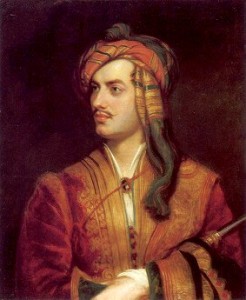With all the hubbub in the art world left over from the Met Gala this past week, we’ve decided to step things up for #fancyfriday. Today’s special: Thomas Phillips’ portrait of the notorious George Gordon, better known as Lord Byron!
Born in 1788, Lord Byron (or, as I like to call him, Lord B) is maybe the best-known of the English Romantic poets. He’s identified more with the later group of Lake Geneva Romantics that included both Mary and Percy Bysshe Shelley. Publication of his first

work, the rather lengthy and somewhat scandalous epic poem “Childe Harold’s Pilgrimage,” in 1812 at the age of 24 cemented his celebrity status in England. His personal life was pretty much akin to what that of a 1980’s hair metal star would have been like at the height of his career, so much so that one of his ex-lovers, Lady Caroline Lamb, immortalized Byron’s notoriety by describing him as “mad, bad, and dangerous to know.” After some well-publicized personal scandals in 1816, the least of which included a separation from his wife and an illicit relationship with a half-sister, he left England for good to live all around Europe. He eventually died assisting the Greeks in their attempt to win freedom from the Ottoman Empire in 1824.
Phillips’ 1813 portrait is probably the most famous of all of the portraits of Byron, as it captures much of Byron’s personality. He’s dressed in an Albanian soldier’s garb that he purchased several years earlier on one of his voyages abroad, hinting at his love for all places the Continent. The outfit is, of course, very over-the-top; Lord B would’ve been the talk of many a dinner party in that getup. Which is of course exactly what he would’ve loved. Lord B is also kind of staring off into the middle distance, perhaps composing verses of poetry in his head. Or checking out Phillips’ wife. Either would be in line with his character. His facial hair is basically the height of fashion, and Phillips has done well to communicate Byron’s good looks back through the generations. This being a portrait, he’s left out the fact that by this point Lord B was growing a little tubby and the fact that he had a club foot.
Upon closer inspection, Phillips’ painting displays some trademarks of Romantic paintings despite its being a portrait. The edges of Lord B’s coat aren’t distinct lines as much as they are soft brushstrokes that fade into the darker background. Same with the gold brocade. This rougher style of painting in which the brushstrokes are clearly visible was popular among Romantic art, as they preferred to communicate the emotion of a piece rather than the reasonable clean lines more associated with Neoclassical strain of art. Lord B chose an excellent painter for his portrait–with its heavy brushstrokes, Phillips’ portrait immortalizes Byron as the poet genius with a flair for the scandalous.
Phillips’ portrait of Lord B now hangs in the National Portrait Gallery in London–a rather ironic home for him, since he left London in the wake of personal scandal. In addition, Byron’s companions in the National Portrait Gallery contain a lot of politicians of his day that he and Percy Bysshe Shelley probably spent hours making fun of. But this portrait’s placement in the National Portrait Gallery cements his place in not only the history of English literature, but the history of the nation itself.
Want to know more about our illustrious Lord B? Check out an extremely comprehensive biography from the Poetry Foundation here. Don’t see what the big deal is about this Lord B guy? Let us know in the comments below!







